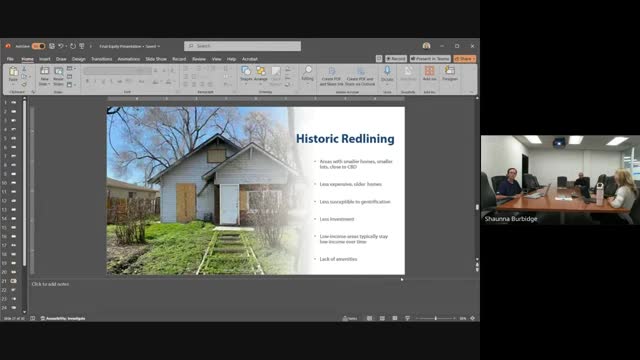Salt Lake City neighborhoods face decline amid suburban flight
October 13, 2024 | Utah Department of Transportation, Utah Transportation, State Agencies, Organizations, Utah Executive Branch, Utah
This article was created by AI summarizing key points discussed. AI makes mistakes, so for full details and context, please refer to the video of the full meeting. Please report any errors so we can fix them. Report an error »

In a recent government meeting, officials discussed the socio-economic dynamics of neighborhoods in Salt Lake City, particularly focusing on areas characterized by smaller homes and lots, which are often more affordable. These neighborhoods, such as Glendale and Rose Park, were historically developed when automobile ownership was limited, leading residents to rely on public transit and live closer to the central business district.
The meeting highlighted that these areas tend to attract lower-income families who cannot afford larger, newer homes. As a result, they are less susceptible to gentrification unless significant developer interest arises. However, the lack of disposable income among residents often leads to minimal investment in property upkeep and local amenities, creating a cycle of decline.
Officials noted a concerning trend of suburban flight, where families with children are moving to suburban areas for better living conditions, including larger homes and access to quality schools. This shift has resulted in a decrease in student populations in urban schools, prompting the Salt Lake School District to consider closing several elementary schools due to insufficient enrollment.
The discussion also touched on the impact of the COVID-19 pandemic, which has led to an increase in homeschooling and a drop in school attendance among lower-income families. This has further strained local educational resources, as schools struggle to maintain their student bodies.
Conversely, the meeting pointed out that neighborhoods near higher education institutions are experiencing a different set of challenges. These areas often have a transient population of students who contribute to a lower investment in the community. Property owners may neglect maintenance, knowing that student renters are typically short-term occupants. Additionally, the presence of universities often reduces the need for local amenities, as students rely on campus facilities.
Overall, the meeting underscored the complex interplay between housing affordability, community investment, and educational resources in Salt Lake City, revealing significant implications for urban planning and policy development moving forward.
The meeting highlighted that these areas tend to attract lower-income families who cannot afford larger, newer homes. As a result, they are less susceptible to gentrification unless significant developer interest arises. However, the lack of disposable income among residents often leads to minimal investment in property upkeep and local amenities, creating a cycle of decline.
Officials noted a concerning trend of suburban flight, where families with children are moving to suburban areas for better living conditions, including larger homes and access to quality schools. This shift has resulted in a decrease in student populations in urban schools, prompting the Salt Lake School District to consider closing several elementary schools due to insufficient enrollment.
The discussion also touched on the impact of the COVID-19 pandemic, which has led to an increase in homeschooling and a drop in school attendance among lower-income families. This has further strained local educational resources, as schools struggle to maintain their student bodies.
Conversely, the meeting pointed out that neighborhoods near higher education institutions are experiencing a different set of challenges. These areas often have a transient population of students who contribute to a lower investment in the community. Property owners may neglect maintenance, knowing that student renters are typically short-term occupants. Additionally, the presence of universities often reduces the need for local amenities, as students rely on campus facilities.
Overall, the meeting underscored the complex interplay between housing affordability, community investment, and educational resources in Salt Lake City, revealing significant implications for urban planning and policy development moving forward.
View full meeting
This article is based on a recent meeting—watch the full video and explore the complete transcript for deeper insights into the discussion.
View full meeting

